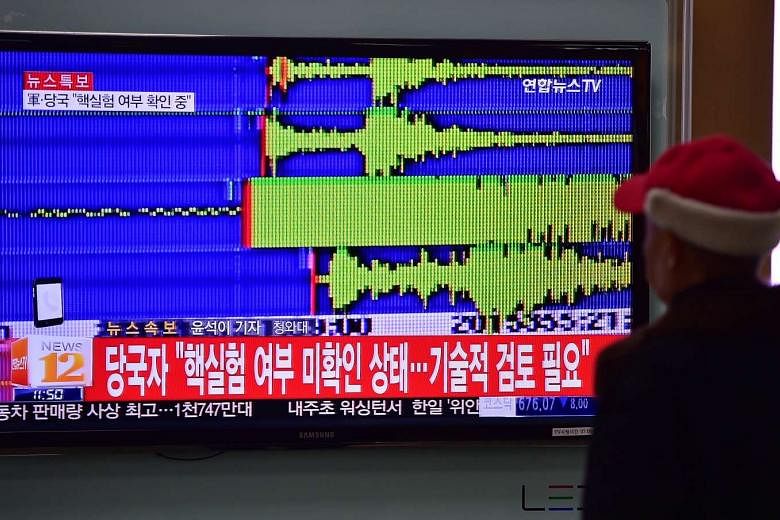North Korea claimed on Wednesday (Jan 6) that it had successfully tested its first hydrogen bomb, the fourth time it had detonated a nuclear device.
But South Korean intelligence officials and analysts have questioned whether it was a full-fledged test of a hydrogen device.
Here's what you should know about hydrogen bombs and North Korea's latest test.
What is a hydrogen bomb?
A hydrogen bomb is more powerful than other nuclear weapons as it fuses atoms together to create a much larger amount of energy, rather than by tearing atoms apart (atomic fission).
"Nuclear weapons based on fission typically have a yield of around 10 kilotonnes or so, while nuclear weapons employing fusion can have a yield measured in megatonnes," said Mr Bruce Bennett, a defence analyst at the Rand Corporation. A megatonne is equivalent to 1,000 kilotonnes.
A hydrogen bomb - also known as a thermo-nuclear bomb - is hundreds of times more powerful than the atomic bomb that devastated Hiroshima in 1945. It is also seen as "cleaner" than an atomic bomb as it has less radioactive fallout, although it is more powerful.
It can be fitted in warheads of ballistic missiles.
What we know about the latest test?
The North Korean device had a yield of about 6 kilotonnes of TNT, roughly the same size as the last test, which was equivalent to 6 to 7 kilotonnes.
"Given the scale, it is hard to believe this is a real hydrogen bomb," said Dr Yang Uk, a senior research fellow at the Korea Defence and Security Forum. "They could have tested some middle stage kind (of device) between an A-bomb and H-bomb, but unless they come up with any clear evidence, it is difficult to trust their claim."
Dr Joe Cirincione, a nuclear expert who is president of Ploughshares Fund, a global security organisation, said North Korea may have mixed a hydrogen isotope in a normal atomic fission bomb.
"Because it is, in fact, hydrogen, they could claim it is a hydrogen bomb," he said. "But it is not a true fusion bomb capable of the massive multi-megaton yields these bombs produce".
Which countries have hydrogen bombs?
Only a few countries are known to have hydrogen bombs: the United States, Russia, the United Kingdom, France, China and India .
Israel is strongly suspected to possess hydrogen bombs but it has yet to confirm or deny this.
When were the previous nuclear tests?
Oct 9, 2006
In its first test, Pyongyang exploded a device based on plutonium, rather than enriched uranium. The test was conducted at P'unggye-yok.
US intelligence officials later said that analysis of radioactive debris in air samples collected a few days after the test confirmed that the blast had taken place. But they estimated that it had not been a powerful one, measuring less than 1 kilotonne, less than a tenth of the size of the bomb dropped on Hiroshima. This raised questions about the sophistication and effectiveness of the weapon.
In response to the test, the United Nations approved military and economic sanctions against North Korea. After years of talks, Pyongyang agreed in February 2007 to shut down its main nuclear reactor at Yongbyon in return for aid and diplomatic concessions.
But negotiations stalled as North Korea accused the US, South Korea, Japan, China and Russia of failing to meet agreed obligations.
May 25, 2009
Barely a month after North Korea walked out of international talks on its nuclear programme, it carried out its second underground nuclear test, which was said to be more powerful than the first.
Russia estimated a blast of up to 20 kilotonnes, a similar size to the bombs that completely destroyed Hiroshima and Nagasaki in 1945.
North Korea gave no details of the test location, but South Korea said a seismic tremor was detected in the north-east around the town of Kilju - close to P'unggye-yok.
After the test, an official communique stated that it was "part of measures to enhance the republic's self-defensive nuclear deterrent in all directions".
The UN issued a resolution condemning the nuclear test and tightened sanctions. After the US imposed tough sanctions in August 2009, President Kim Jong Il said he was willing to resume nuclear talks.
Feb 12, 2013
North Korea tested what it called a "miniaturised and lighter nuclear device" in its third test.
"It was confirmed that the nuclear test that was carried out at a high level in a safe and perfect manner using a miniaturised and lighter nuclear device with greater explosive force than previously did not pose any negative impact on the surrounding ecological environment," South Korea's Korean Central News Agency said.
Source: BBC, CNN, Telegraph, Agence France-Presse

